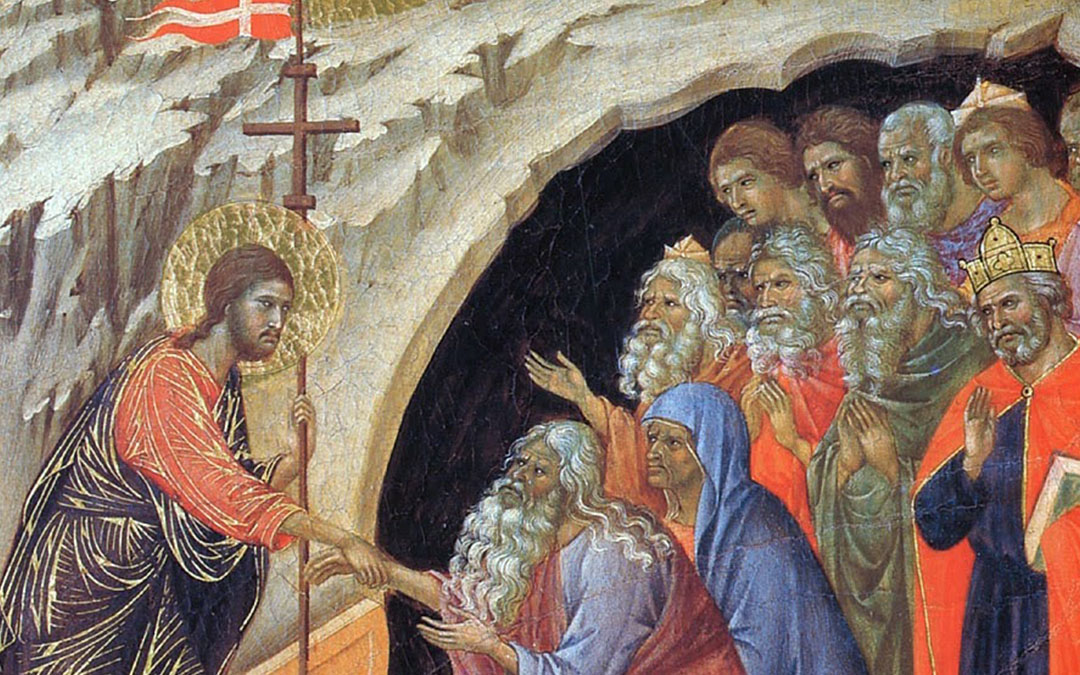Questions and answers
Doctrinal Commission – International Catholic Charismatic Renewal Services
Year 2016
When the Apostles’ Creed states that Christ “descended into hell,” it does not explain why or in what way. However, as part of the Paschal Mystery, set between the cross and the resurrection, the descent into hell must have a meaning for our salvation. We will explain the three main ways in which it is a central part of Christ’s saving action, and then add a final comment.
However, before that, we must understand that while in English we only have one word for hell, the Bible has at least two: Hades (Sheol in Hebrew) and Gehenna.
Sheol is the ‘place’ of the dead, who are like shadows cut off from the living and from God (Psalm 6:6; 88:11-13), but who can in some cases await the coming of the Savior. Sheol was thought of as being in the ‘lower regions,’ ‘under the earth’.
Gehenna, on the other hand, is a ‘place’ of fire and suffering for the damned—those who have refused Christ’s salvation in a definitive way (see Mt 13:40, 50; 18:8-19)—and for the devil and demons (see Mt 25:41). The Church teaches that from ‘hell’ in this second sense there is no coming back, because those who are there have made a definitive choice against God (see CCC 1035).
The first meaning of Christ’s descent into hell is that he truly died and by doing so vanquished death. The Scriptures say little about the descent into hell, but when they do they refer to the Sheol, the place of death: “The Son of Man will be three days and three nights in the heart of the earth” (Mt 12:40); Christ “descended into the lower regions of the earth” (Eph 4:9). Acts 2:27 puts on Christ’s lips the words of Psalm 16, addressed to God: “You will not abandon my soul to Hades, or let your Holy One see corruption,” implying he will be in Sheol. This is why the New Testament often states that Christ is “brought back from the dead” (Acts 3:5; 13:34; Rom 8:11; 10:7-9; 1 Cor 15:20; Heb 13:20).
The descent into hell means that Christ died and truly shared the human experience of death. Just as by taking our sin upon himself on the cross he frees us from sin, so by entering into the realm of death and being raised by the Father he conquers death, “the last enemy to be destroyed” (1 Cor 15:26; CCC 636). The doors of the realm of death have been opened; death no longer has the last word. Of course, without the resurrection Christ’s descent into hell would be meaningless, but as a part of the Paschal Mystery as a whole, it is the source of all victory over death and over the small ‘deaths’ and ‘hells’ of our daily lives, over “the fear of death” that otherwise holds us “in lifelong slavery” (Cf. Heb 2:15).
The second meaning of Christ’s descent into hell is victory over the devil. It is not said that Christ descended into Gehenna. He let himself be brought down by the power of death and shared the condition of the dead, but it is inconceivable that he put himself under the power of the devil and shared the fate of those who refuse God, either the damned or the demons (CCC 633; 636). However, insofar as the devil “has the power of death” (Heb 2:14), overcoming death means vanquishing him. In this sense the descent into the realm of death is the ultimate way for Christ to “enter into the strong man’s house,” the house of evil, and “bind the strong man” (see Mt 12:29; Lk 11:21-22. See Benedict XVI, Jesus of Nazareth, I, p. 20). Once again, as a part of the Paschal Mystery as a whole, Jesus’ descent is the source of all limits set to the devil’s power and all victories over evil spirits.
In these first two senses Jesus’ victory over death and the devil concerns the whole human race in all times and places. A third meaning of Christ’s descent into hell, however, is that it brings salvation in a more specific way for the righteous who lived and died before him. Very early on, the Church Fathers wondered how salvation could reach those who preceded the coming of the Savior. The descent into hell brought the answer, because Christ could thus touch those who were in Sheol awaiting his coming in faith: “The Gospel was preached even to those who are dead” (1 Peter 4:6; CCC 633-634; 637). Some icons beautifully depict Christ, after having broken down the doors of hell, seizing Adam by the wrist to wrench him out of the pit of death.
A fourth meaning that can contribute to our spiritual life may be added. Though the crucifixion and the apparitions of the Risen Lord are visible moments of the Paschal Mystery, the descent into hell happens outside the range of human perception. This is echoed in the Latin Church by a day of ‘silence’: no liturgical celebration tells of this moment of Christ’s saving action or is specifically devoted to it. We are thus reminded that a great amount of Christ’s work in us happens at a level too deep for us to perceive: in periods in which we feel nothing, it is good to remember that he may be more active than ever, in the most inner recesses of our being, to destroy evil at its roots and set us free.



